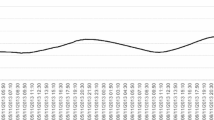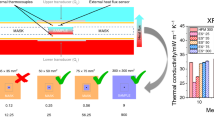Abstract
Unwanted horizontal temperature differences and significant heat losses to surrounding air were observed inside the heated block during saturated nucleate pool boiling experiments. Two possible modifications of the apparatus are suggested: embedding of thermocouples and insulating of the heated block. Both modifications should significantly improve the temperature field inside the heated block for upcoming measurements.
Access provided by Autonomous University of Puebla. Download conference paper PDF
Similar content being viewed by others
1 Introduction
In order to calculate heat-transfer coefficient during nucleate pool boiling, one has to use a correlation, e.g., the one created by Rohsenow [1]
or Forster and Zuber’s [2]
However, it might occur that boiling liquid, geometry, or boiling conditions differ from those for which correlations were prescribed. When this happens, there is a non-negligible uncertainty that cast doubts upon the calculated values.
In order to reduce such an uncertainty, we have designed an apparatus for measurement of heat-transfer coefficient during saturated nucleate pool boiling. The purpose of the apparatus is either to compare the measured coefficients with correlations in order to find a suitable one or to let us formulate our own correlation which would correspond with measured data. Furthermore, we want to use the apparatus for various liquids, which are interesting from the perspective of process engineering, but their heat-transfer coefficients were not yet measured.
This paper deals with two problems encountered during our measurements (unwanted horizontal differences in horizontal direction and the impact of forced convection of ambient air) and offers appropriate solutions for both of these problems based on a literary survey and on consultations with various manufacturers.
2 Methodology
The apparatus, see Fig. 1, is quite usual. We indirectly measure the temperature of the heating surface, i.e., the upper face of a heated stainless-steel block with dimensions of the surface 48 × 48 mm. For that, we use six sheathed thermocouples placed inside the block. Thermocouples were simply inserted into six (two rows of three) 1-mm holes with length of 24 mm. The distance between both rows is 13 mm, and the distance between the upper row and the heating surface is 12 mm. When we subtract temperature of the boiling liquid (measured with seventh thermocouple) from the estimated wall temperature, we obtain superheat and calculate the heat-transfer coefficient with Newton’s cooling law.
3 Results
Since the thermocouples inside the block are aligned in two horizontal rows and the method mentioned above supposes that heat conduction inside the block is one-dimensional, it is expected that the temperatures in a single row should be equal (in the ideal case). However, obtained temperatures were usually significantly shifted. For instance, Fig. 2 shows temperatures obtained on December 19, 2018, after reaching a stable state during boiling of water at atmospheric pressure. Table 1 presents obtained temperatures for dataset in Fig. 2 and for two more datasets obtained after completely dismantling and reassembling the apparatus. Table 1 also presents average temperatures calculated for both upper and bottom lines, calculated heat flux q and heat-transfer coefficient α. For the first dataset, there is a difference around 10 °C between TLL (lower left position) and TLR (lower right). For the upper row, the difference is smaller, but still around 2 °C between TUL (upper left) and TUC (upper center position). For the second dataset, the discrepancy is somewhat lower—around 4.6 °C for the lower row. The third dataset is perhaps the best result we have ever obtained with maximum difference slightly below 3 °C.
It is necessary to mention that we were unable to predict the magnitude of these differences. It could be as low as several °C or as high as 15 or even 20 °C. Furthermore, we were unable to anticipate positions of maximal and minimal temperatures, because they varied for each experimental run. The fact that in Table 1, regarding the temperatures in the lower row of thermocouples, TLL is always the highest and TLR the lowest is just a mere coincidence.
Lastly, we discovered that the measured temperatures are significantly affected by forced convection of ambient air. We tried to blow air over the uninsulated heated block with a hairdryer and found out that the temperatures measured by embedded thermocouples dropped. The actual decrease depended on the angle from which the air was blown.
4 Embedding of Thermocouples
We suppose that the temperature differences inside the block indicate a problem with temperature measurement—most likely with the way thermocouples were installed into the block. Therefore, we did a literary survey in order to find a suitable method for embedding our thermocouples inside the block. There are basically two methods mentioned by various researchers—embedding by melting (soldering, brazing, welding) and embedding with an adhesive.
Embedding by melting is often used for junctions of bare-wire or coated-wire thermocouples, but it might be used for sheathed thermocouples as well. However, we are not convinced that these methods can give a satisfying result considering the 1-mm holes and very narrow space between walls of the holes and thermocouple sheaths.
There are several types of adhesives used for embedment of thermocouples. The most common are various epoxies and cyanoacrylate-based glues. Some special high-temperature adhesives of these types can usually withstand temperatures around 200 or 250 °C. One should thoroughly distinguish between long-term and short-term operating temperatures when comparing several adhesives. Epoxies and cyanoacrylate glues are usually used when boiling of liquid with a lower boiling point or boiling under lower pressure occurs.
Cements, ceramic (alumina) adhesives, or graphite adhesives are usually used for higher-temperature boiling. They can withstand temperatures up to 900 or even 1400 °C. Thermal conductivities of these adhesives are usually just slightly higher than those of epoxies, but they are still quite low (typically around 1 or 2 W m−1 K−1).
The crucial criterion for choosing an appropriate method or a suitable adhesive is the temperature inside the heated block. This temperature depends above all on the boiling point of investigated liquid (that includes pressure), range of heat flux which is being investigated, material of the heated block, and positions of thermocouples inside the block. One should also take heed of viscosity, because the adhesive should fill the 1-mm holes without leaving any air gaps. Thermal conductivity is also important in order to reduce the thermal resistance between the thermocouple sheath and the hole in which the thermocouple is placed.
5 Insulating the Heated Block
Air-blowing over the block proved that the heated block has to be protected from any impact of ambient air. Therefore, we want to enclose the heated block and the cartridge carrier in Fig. 1 with a suitable thermal insulator. In order to find a convenient material, we inquired the scientific papers describing pool boiling apparatuses.
We found out that perhaps the most used materials are various polymers such as Teflon, nylon, polystyrene, bakelite, or PTFE. More heat-resistant often-used polymers are PTFE, PEEK, or PI. Even these materials can be, however, used only at lower temperatures. For instance, the upper working temperature of PI (which is one of the most heat-resistant thermoplastics) lies in the range from 250 to 320 °C. On the other hand, polymers have very low thermal conductivities—typically from 0.1 to 0.5 W m−1 K−1.
Another often-mentioned material is ceramic. Such insulations are usually in the form of tablets, blankets made of ceramic fibers, or even special custom-made parts. The advantage of ceramic is an outstanding thermal stability. There are several types of ceramic. Aluminosilicate ceramic can be typically used up to 1500 °C, and some other types such as boron nitride ceramic easily exceed these limits. Thermal conductivity of ceramic varies a lot. More sintered ceramic is characterized with lower resistance against temperature shocks, but higher solidity. It can have conductivities around 7 W m−1 K−1. More porous ceramic has higher permeability to moisture, but endure larger temperature shocks and its thermal conductivity is generally lower—typically around 2 W m−1 K−1. Special types of ceramic can withstand large temperature shocks and remain impermeable, but conductivities of these types are as high as 15 W m−1 K−1.
Third common method is to insulate the block with a wool such as glass or fiberglass wools, mineral, rock, or kaolin wools. Usually, wools offer very low thermal conductivities which are typically lower than 0.1 W m−1 K−1. On the other side, they do not perform well in wet environments and their pliability is rather a disadvantage.
We should at least mention some less-common materials such as firebricks, clay bricks, glass, or mica. Of course, several insulation materials might be combined. For example, in [3] copper-heated block was placed on ceramic insulators and the whole assembly was put into housing made of PEEK. Sometimes, vacuum is artificially created in order to insulate a block. It is also possible to leave an air gap between the block and the insulating material. The gap then serves as an insulation, as is mentioned in [4].
The crucial criterion for the right choice of an insulating material is the same as for adhesives, i.e., the operating temperature. Some other important properties to consider are thermal conductivity, machinability, moisture permeability, a possible change of insulating properties when the material becomes moistened, thermal-shock resistance, solidity, or thermal expansion of the material.
After thorough consideration, we have decided to use Foamglas® Perinsul S for our apparatus for its remarkably low thermal conductivity (lower than 0.05 W m−1 K−1), operational temperature up to 430 °C, sufficient wear hardness and strength, water resistance, and impermeability for steam. We are going to test the modification in the near future.
6 Conclusions
This contribution deals with temperature distribution inside a heated block of an apparatus for research of saturated nucleate pool boiling. It aims at two problems—unwanted temperature differences inside the heated block and influence of ambient air on temperature field inside the block. Remedial actions are briefly described.
References
W.M. Rohsenow, A Method of Correlating Heat Transfer Data for Surface Boiling of Liquids. Technical report. Division of Industrial Cooperation, Heat Transfer Laboratory, Cambridge, MA, USA (1952)
H.K. Forster, N. Zuber, Dynamics of vapor bubbles and boiling heat transfer. AIChE J. 1(4), 531–535 (1955)
T.Y. Kim, J.A. Weibel, S.V. Garimella, A free-particles-based technique for boiling heat transfer enhancement in a wetting liquid. Int. J. Heat Mass Transf. 71, 808–817 (2014)
S. Petrovic, T. Robinson, R.L. Judd, Marangoni heat transfer in subcooled nucleate pool boiling. Int. J. Heat Mass Transf. 47(23), 5115–5128 (2004)
Acknowledgements
This work was supported by the Ministry of Education, Youth and Sports of the Czech Republic under OP RDE grant number CZ.02.1.01/0.0/0.0/16_019/0000753 “Research centre for low-carbon energy technologies” and by the Grant Agency of the Czech Technical University in Prague, grant No. SGS18/129.
Author information
Authors and Affiliations
Corresponding author
Editor information
Editors and Affiliations
Rights and permissions
Copyright information
© 2021 Springer Nature Singapore Pte Ltd.
About this paper
Cite this paper
Vajc, V., Dostál, M. (2021). Fixation of Thermocouples and Insulation for Heated Block. In: Wen, C., Yan, Y. (eds) Advances in Heat Transfer and Thermal Engineering . Springer, Singapore. https://doi.org/10.1007/978-981-33-4765-6_13
Download citation
DOI: https://doi.org/10.1007/978-981-33-4765-6_13
Published:
Publisher Name: Springer, Singapore
Print ISBN: 978-981-33-4764-9
Online ISBN: 978-981-33-4765-6
eBook Packages: EngineeringEngineering (R0)






